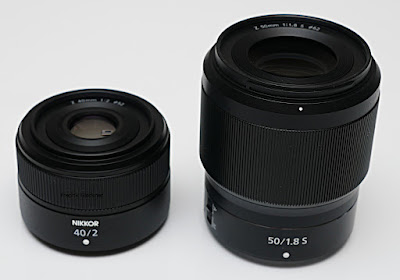Nikkor Z 105mm f/2.8 S macro lens review
The Nikkor 105mm f/2.8 S and 50mm f/2.8 macro lenses for the Z mount, or micro as Nikon says, were announced at the same time. Both are 1:1 capable macro lenses, but they have major differences beyond the focal length. The 105mm lens has the premium "S" label, and has optical image stabilization built in. Also, it has a small LCD screen to show the focus distance or aperture. Finally, while the 105mm has internal focusing, the 50mm macro lens focuses by extending the front lens assembly. This probably makes the 50mm lens more fragile and less water/dust resistant.
While the 105mm f/2.8 is the more expensive one, it is in fact priced quite competitively compared with peer lenses, more about that later. The 50mm lens, on the other hand, while it is priced lower, the price point is surprisingly high for what you get. So I expect that interest in the 50mm macro is going to be rather low, while the 105mm lens has been popular and hard to find.
Here is an overview of competing lenses of similar specs from Canon and Sony. Note that the Nikon lens is the least expensive, while it appears to have all the features.
| Nikkor Z 105mm f/2.8 S | Canon RF 100mm f/2.8 L | Sony FE 90mm f/2.8 G | |
| Announced | 2021 | 2021 | 2015 |
| Lens elements/groups | 16/11 | 17/13 | 17/13 |
| Diaphragm blades | 9 | 9 | 9 |
| Weight | 630g | 730g | 872g |
| Length | 140mm | 148mm | 114mm |
| Diameter | 85mm | 82mm | 83mm |
| Filter thread | 62mm | 67mm | 77mm |
| Optical image stabilization | Yes | Yes | Yes |
This puts the Nikon lens in the unusual position of being a "bargain" compared with peer camera systems.
Physical appearance
Overall, the lens has a very nice, high quality feel to it. The focus ring is covered with a rubberized material, and is nicely dampened. Of course, it controls the actual focus through the focus motor, it is not mechanically connected to the focus. Beyond the two rotating rings and buttons and switches, there is nothing that moves on the lens. The focusing is internal, and there is a rubber seal ring around the mount. This should make the lens more resistant to water and dust.
What looks like a ring at the very front of the lens barrel, is in fact a thinner, rubberized rigid ring designed for you to hold the lens steadily. And that is a great addition, otherwise you might risk knocking the focus off if you hold it by the focus ring. Towards the back of the camera, there is an even thinner ring that can be set to control the lens aperture.
In this demonstration, the aperture is first closed down to the minimum, which increases the depth of field, illustrated with the white line. Then the focus ring is rotated to change the focus distance to the minimum. You'll see that the depth of field decreases again when focusing closer.
There is a plastic hood included, which is quite nice. In addition to the usual bayonet mount, it also locks in place with a small tab that has to be pushed to remove it. I wonder if this was really necessary. Most lenses have a bayonet hood without any locking tab, and they work just fine.
I know that some have complained that the lens doesn't have a tripod foot. Sure, that would be a useful addition. However, I think the lens barrel would have needed a lot of strengthening to support a tripod foot, which would have made the lens much heavier. So I think the design is a nice compromise: Make the lens lighter, and then it is more feasible to mount it on a tripod via the camera anyway.
Here is the lens mounted to the Nikon Z7 (left). I am going to be comparing it with the Panasonic/Leica 45mm f/2.8 1:1 macro lens, seen mounted to the Lumix GH5 to the right.
Image quality
To test the lens, I have taken the same picture at different apertures, and with the two lenses above:
| Nikkor 105mm f/2.8 S | Leica 45mm f/2.8 |
To better compare the images, I have compiled 100% crops from the centre of both images at various apertures:
And from the lower left corner:
What we see here, is that the Nikon lens shows a truly amazing image quality. In the centre, it is as sharp as it gets already from wide open, at f/2.8. In the corner, we can see that the sharpness is slightly worse at f/2.8 compared with stopped down to f/4, but the diffence is so small that noone would notice in a real world image. Also, there is some vignetting at f/2.8, but again the effect is quite small. Overall, the image quality is very impressive.
Bokeh
The term bokeh refers to the nature of the out of focus rendering of a lens. Ideally the bokeh should be smooth, in the sense that out of focus areas should be evenly smeared out, and not attract attention. I have some example images to illustrate what the bokeh looks like:
| f/2.8 | f/4 |
| f/5.6 | f/8 |
We can see that at large apertures, the out of focus highlights are rendered cat-eye shaped, oval, and more so towards the corners of the frame. This is mildly annoying, it would have been better if they had been perfectly round all over the frame.
Here is another example taken in a low contrast situation. The bokeh looks smooth:
| f/11 | f/2.8 |
Conclusion
The Nikkor 105mm f/2.8 S Micro is a competitively priced macro lens with a premium build quality and awesome image quality. It has good ergonomics, is very well designed for photographers, with a good focus by wire manual focus ring.
The use cases for such a lens of course include macro work, i.e., photographing small items. However, you could also use it as a portrait lens. Portrait lenses are usually 85mm, like the Nikkor Z 85mm f/1.8 S, but the extra 20mm essentially means that you have to take one more step back away from the subject when photographing a person's head. So stay around 4-5 feet from the subject and you should be fine.
You could also use it as a general purpose tele lens, although for this use again the Nikkor Z 85mm f/1.8 S would be the better choice as it is smaller and less expensive.
So I guess it makes sense to say that the The Nikkor 105mm f/2.8 S Micro is mostly for those who would like to give macro photography a try, while it can also be used for portrait and other general tele use.
On the other hand, you could also buy this lens to enjoy the awesome image quality, the good build, and the sensible ergononomics.
Affiliate links
Example videos
Example images
f/11, 1/250s, ISO 320
f/8, 1/250s, ISO 100
f/14, 1/250s, ISO 250
f/5, 1/250s, ISO 90
f/16, 1/250s, ISO 800






















Comments
Post a Comment